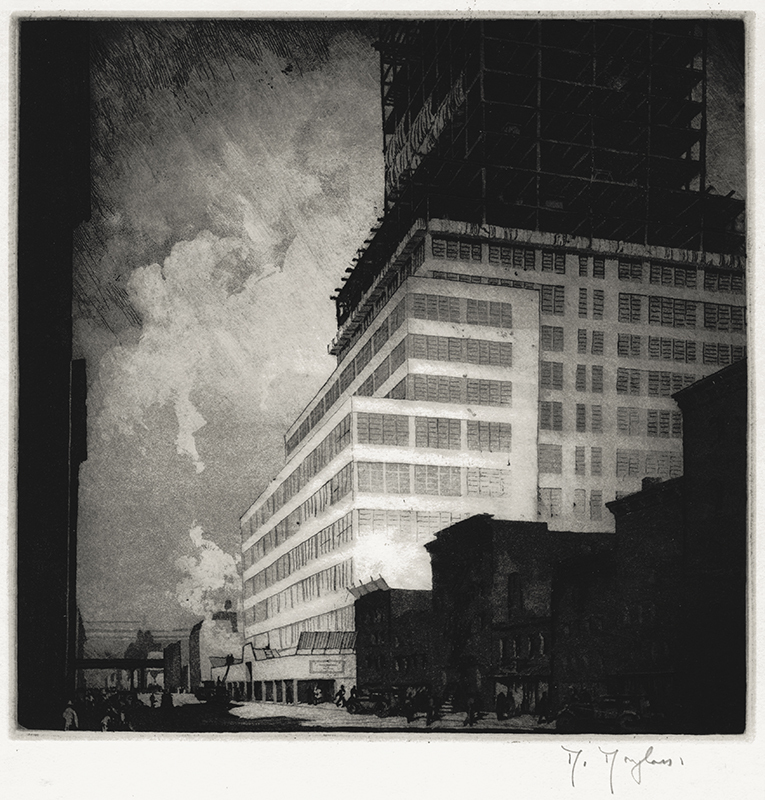
19th, 20th & 21st Century Fine Prints
707-546-7352 · fax 707-546-7924 · web: www.annexgalleries.com · email: artannex@aol.com
McGraw-Hill Building Under Construction by Donald Douglass

McGraw-Hill Building Under Construction
Donald Douglass
McGraw-Hill Building Under Construction
Donald Douglass
1899 - 1971 (biography)This intaglio is illustrated on page 17 in the exhibition catalogue "Raymond Hood and the American Skyscraper" at the David Winton Bell Gallery, Brown University, 2020. The catalogue notes:
"The emphasis on horizontal lines and large dramatic windows was unique among New York skyscrapers and captured the attention of curators at the Museum of Modern Art, who included the McGraw-Hill Building in their famous 1932 exhibition on modern architecture.
Hood’s skyscraper exhibited features of the so-called International Style, such as the crisp, precise lines and horizontal bands of windows that extended around the corners—only made possible by the use of an internal steel frame. This etching shows sections of the steel frame both before and after it is wrapped in glass and terra cotta."
Printmaker and architect Donald McNutt Douglass was born Donald Edwin McNutt in Houston, Texas, on December 7, 1899. His surname changed to “Douglass” after his widowed mother remarried, and he was raised in Chicago, IL. He attended Yale University and from 1922 to 1923 he traveled and studied in Europe. Upon his return to the United States he settled in New York, where he took a position at the architecture firm of art deco architect Raymond M. Hood in 1924.
Douglass was the author of “Rebecca’s Pride” a murder mystery, published in 1956. He was listed in the 1950 census as being an “architect and builder”. He worked as an architect for the American Consular Service and was stationed in Germany in 1930. Donald M. Douglass died in Curacao, Netherlands Antilles at the U.S. Consulate in September, 1971.
Little else is currently found about Douglass, and the only readily available mention of him is an article in Pencil Points - An Illustrated Monthly Journal for the Drafting Room, New York (pp. 651 - 662/cont. p. 700), 1927. In the extensive write-up on the artist and his preferred medium, aquatint, there are nine reproductions of his aquatints, all of them focusing on the architecture of Joseph Urban and Raymond M. Hood - his employers - as well as reproductions of his precise draftsman’ssketches in preparation for future plates. A brief mention of his birth date and state is about all that is offered on the biography of Douglass himself. According to the article, Douglass was a champion - indeed, a very opinionated one - of the aquatint medium and its significance not only to the art world, but to architectural drafting as well.
In the article, Douglass states that up until his excursions into the aquatint medium, very few artists had mastered it, andnone of them exclusively. He quoted printmaker and author Joseph Pennell as saying “that it was the most difficult form of etching - which shows that he knew nothing about it.” Douglas opined: “Goya uses it, but badly. Brangwyn uses it, but only as an auxiliary and means to an end. I have seen two prints in my life that showed acommanding mastery. Most aquatints are terrible. And they have this quality because the possibilities of the medium are under-rated." His work “Title Insurance and Trust Company Building, Los Angeles” appeared both in 1928’s Architectural Forum and Pencil Points and the study “New York Life Building, New York” appeared in Domestic Engineering that same year.


